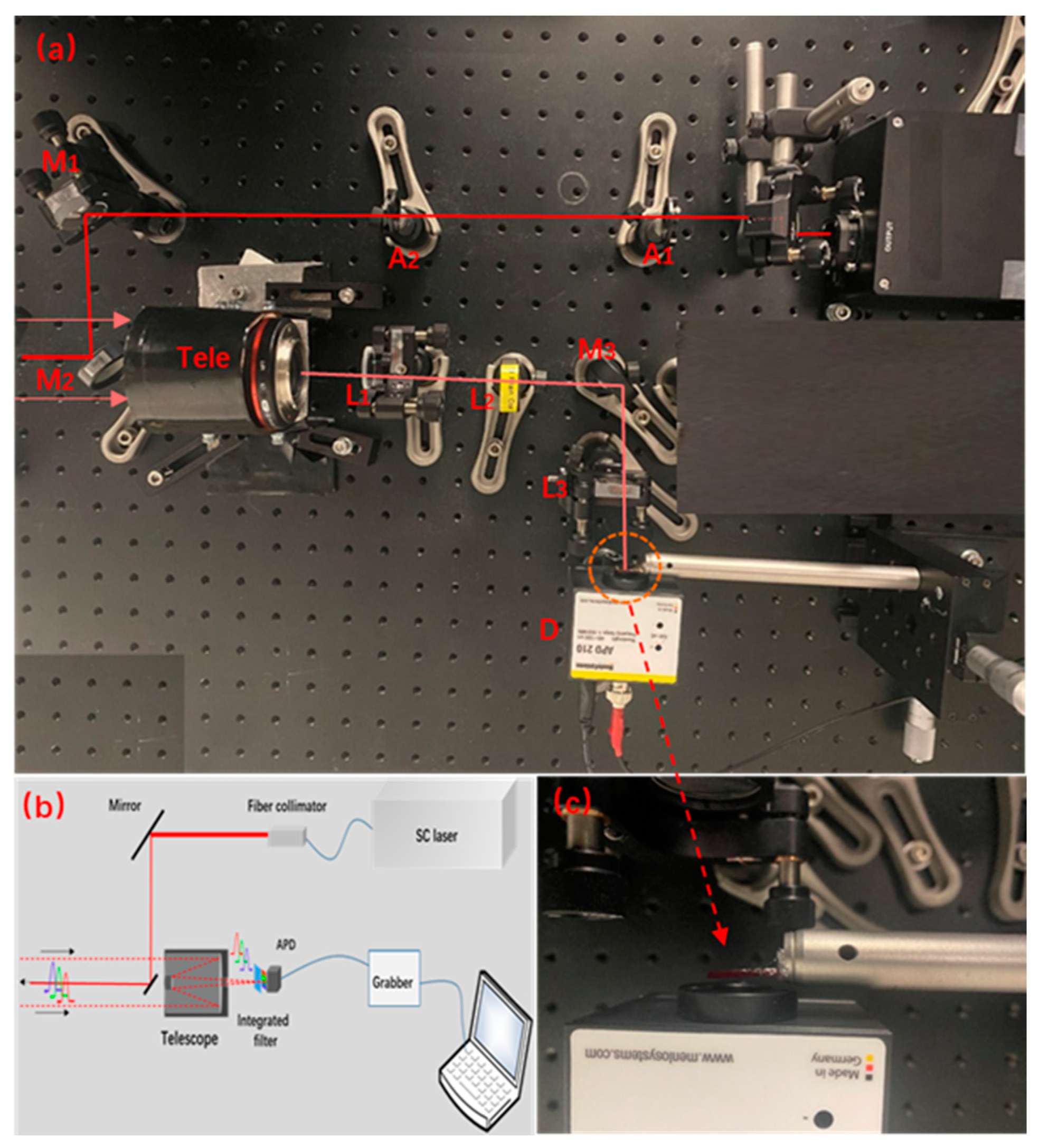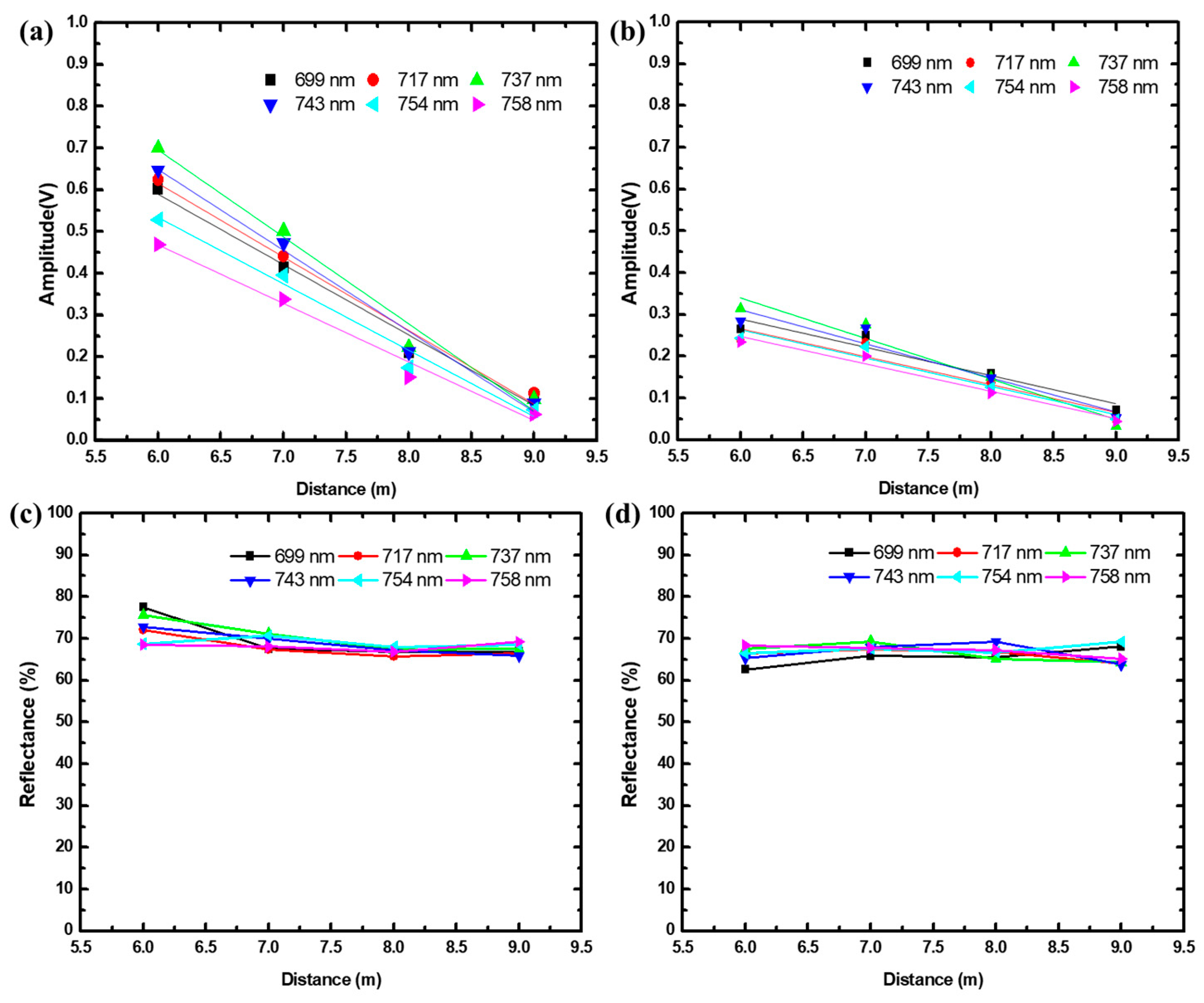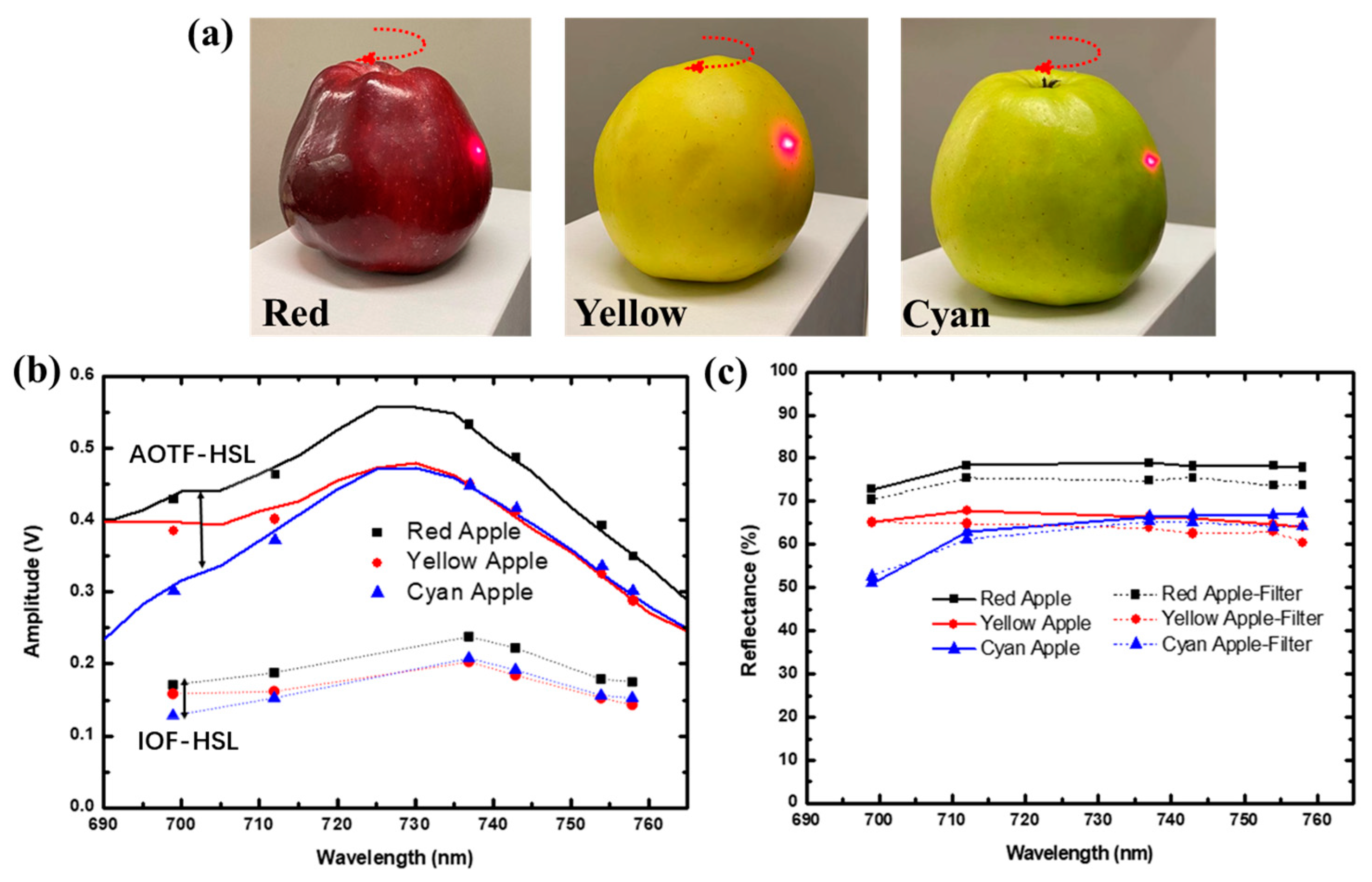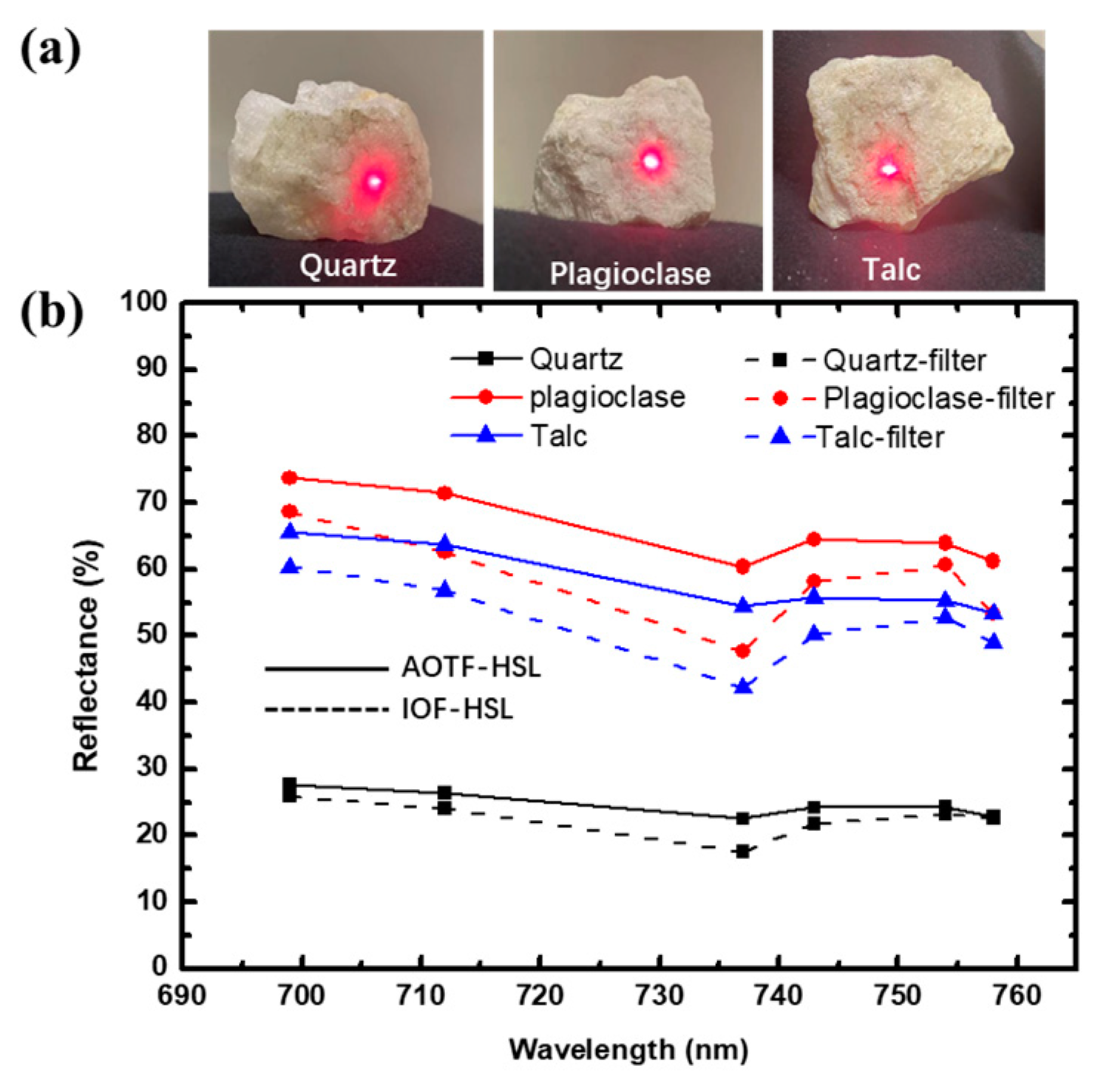Miniaturizing Hyperspectral Lidar System Employing Integrated Optical Filters
Abstract
:1. Introduction
2. System Configuration and Experiment
2.1. IOF Component
2.2. System Configuration
2.3. Experiments System
3. Typographical Style
3.1. System Calibration
3.2. Ranging
3.3. Spectral Profiles
3.4. Coupling IOF and Sensor
4. Conclusions
Author Contributions
Funding
Data Availability Statement
Conflicts of Interest
References
- Kaasalainen, S.; Lindroos, T.; Hyyppa, J. Toward Hyperspectral Lidar: Measurement of Spectral Backscatter Intensity With a Supercontinuum Laser Source. IEEE Geosci. Remote Sens. Lett. 2007, 4, 211–215. [Google Scholar] [CrossRef]
- Sun, J.; Shi, S.; Gong, W.; Yang, J.; Du, L.; Song, S.; Chen, B.; Zhang, Z. Evaluation of hyperspectral LiDAR for monitoring rice leaf nitrogen by comparison with multispectral LiDAR and passive spectrometer. Sci. Rep. 2017, 7, 40362. [Google Scholar] [CrossRef]
- Ghamisi, P.; Rasti, B.; Yokoya, N.; Wang, Q.M.; Hofle, B.; Bruzzone, L.; Bovolo, F.; Chi, M.M.; Anders, K.; Gloaguen, R.; et al. Multisource and multitemporal data fusion in remote sensing a comprehensive review of the state of the art. IEEE Geosci. Remote Sens. Mag. 2019, 7, 6–39. [Google Scholar] [CrossRef]
- Huo, L.-Z.; Silva, C.A.; Klauberg, C.; Mohan, M.; Zhao, L.-J.; Tang, P.; Hudak, A.T. Supervised spatial classification of multispectral LiDAR data in urban areas. PLoS ONE 2018, 13, e0206185. [Google Scholar] [CrossRef] [PubMed]
- Fernandez Diaz, J.; Carter, W.; Glennie, C.; Shrestha, R.; Pan, Z.; Ekhtari, N.; Singhania, A.; Hauser, D.; Sartori, M. Capability Assessment and Performance Metrics for the Titan Multispectral Mapping Lidar. Remote Sens. 2016, 8, 936. [Google Scholar] [CrossRef]
- Wallace, A.M.; McCarthy, A.; Nichol, C.J.; Ren, X.M.; Morak, S.; Martinez-Ramirez, D.; Woodhouse, I.H.; Buller, G.S. Design and Evaluation of Multispectral LiDAR for the Recovery of Arboreal Parameters. IEEE Trans. Geosci. Remote Sens. 2013, 52, 4942–4954. [Google Scholar] [CrossRef]
- Song, S.; Wang, B.; Gong, W.; Chen, Z.; Lin, X.; Sun, J.; Shi, S. A new waveform decomposition method for multispectral LiDAR. ISPRS J. Photogramm. Remote Sens. 2019, 149, 40–49. [Google Scholar] [CrossRef]
- Liu, H.; Yu, T.; Hu, B.; Hou, X.; Zhang, Z.; Liu, X.; Liu, J.; Wang, X.; Zhong, J.; Tan, Z.; et al. UAV-Borne Hyperspectral Imaging Remote Sensing System Based on Acousto-Optic Tunable Filter for Water Quality Monitoring. Remote Sens. 2021, 13, 4069. [Google Scholar] [CrossRef]
- Aruffo, E.; Chiuri, A.; Angelini, F.; Artuso, F.; Cataldi, D.; Colao, F.; Fiorani, L.; Menicucci, I.; Nuvoli, M.; Pistilli, M.; et al. Hyperspectral Fluorescence LIDAR Based on a Liquid Crystal Tunable Filter for Marine Environment Monitoring. Sensors 2020, 20, 410. [Google Scholar] [CrossRef]
- Hegyi, A.; Martini, J. Hyperspectral imaging with a liquid crystal polarization interferometer. Opt. Express 2015, 23, 28742–28754. [Google Scholar] [CrossRef]
- Du, L.; Gong, W.; Shi, S.; Yang, J.; Sun, J.; Zhu, B.; Song, S. Estimation of rice leaf nitrogen contents based on hyperspectral LIDAR. Int. J. Appl. Earth Obs. Geoinf. 2016, 44, 136–142. [Google Scholar] [CrossRef]
- Sun, H.; Wang, Z.; Chen, Y.; Tian, W.; He, W.; Wu, H.; Zhang, H.; Tang, L.; Jiang, C.; Jia, J.; et al. Preliminary verification of hyperspectral LiDAR covering VIS-NIR-SWIR used for objects classification. Eur. J. Remote Sens. 2022, 55, 291–303. [Google Scholar] [CrossRef]
- Devgan, P.S.; Pruessner, M.W.; Urick, V.J.; Williams, K.J. Detecting Low-Power RF Signals Using a Multimode Optoelectronic Oscillator and Integrated Optical Filter. IEEE Photon Techl. 2009, 22, 152–154. [Google Scholar] [CrossRef]
- D’Alessandro, A.; Donisi, D.; De Sio, L.; Beccherelli, R.; Asquini, R.; Caputo, R.; Umeton, C. Tunable integrated optical filter made of a glass ion-exchanged waveguide and an electro-optic composite holographic grating. Opt. Express 2008, 16, 9254–9260. [Google Scholar] [CrossRef]
- Wang, S.-W.; Chen, X.; Lu, W.; Wang, L.; Wu, Y.; Wang, Z. Integrated optical filter arrays fabricated by using the combinatorial etching technique. Opt. Lett. 2006, 31, 332–334. [Google Scholar] [CrossRef] [PubMed]
- Agrawal, P.; Tack, K.; Geelen, B.; Masschelein, B.; Moran, P.M.A.; Lambrechts, A.; Jayapala, M. Characterization of VNIR Hyperspectral Sensors with Monolithically Integrated Optical Filters. Electron. Imaging 2016, 28, 1–7. [Google Scholar] [CrossRef]
- Mao, C.-X.; Gao, S.; Wang, Y.; Wang, Z.; Qin, F.; Sanz-Izquierdo, B.; Chu, Q.-X. An Integrated Filtering Antenna Array With High Selectivity and Harmonics Suppression. IEEE Trans. Microw. Theory Tech. 2016, 64, 1798–1805. [Google Scholar] [CrossRef]
- Wang, S.-W.; Li, M.; Xia, C.-S.; Wang, H.-Q.; Chen, X.-S.; Lu, W. 128 channels of integrated filter array rapidly fabricated by using the combinatorial deposition technique. Appl. Phys. B 2007, 88, 281–284. [Google Scholar] [CrossRef]
- Xuan, Z.; Wang, Z.; Liu, Q.; Huang, S.; Yang, B.; Yang, L.; Yin, Z.; Xie, M.; Li, C.; Yu, J.; et al. Short-Wave Infrared Chip-Spectrometer by Using Laser Direct-Writing Grayscale Lithography. Adv. Opt. Mater. 2022, 10.19, 2200284. [Google Scholar] [CrossRef]
- Escobar, D.E.; Everitt, J.H.; Davis, M.R.; Fletcher, R.S.; Yang, C. Relationship between Plant Spectral Reflectances and their Image Tonal Responses on Aerial Photographs. Geocarto Int. 2002, 17, 65–76. [Google Scholar] [CrossRef]
- Main, R.; Cho, M.A.; Mathieu, R.; O’Kennedy, M.M.; Ramoelo, A.; Koch, S. An investigation into robust spectral indices for leaf chlorophyll estimation. ISPRS J. Photogramm. Remote Sens. 2011, 66, 751–761. [Google Scholar] [CrossRef]
- Hakala, T.; Suomalainen, J.; Kaasalainen, S.; Chen, Y. Full waveform hyperspectral LiDAR for terrestrial laser scanning. Opt. Express 2012, 20, 7119–7127. [Google Scholar] [CrossRef] [PubMed]
- Buschmann, C.; Lenk, S.; Lichtenthaler, H.K. Reflectance spectra and images of green leaves with different tissue structure and chlorophyll content. Isr. J. Plant Sci. 2012, 60, 49–64. [Google Scholar] [CrossRef]
- Xie, Q.; Dash, J.; Huang, W.; Peng, D.; Qin, Q.; Mortimer, H.; Casa, R.; Pignatti, S.; Laneve, G.; Pascucci, S.; et al. Vegetation Indices Combining the Red and Red-Edge Spectral Information for Leaf Area Index Retrieval. IEEE J. Sel. Top. Appl. Earth Obs. Remote Sens. 2018, 11, 1482–1493. [Google Scholar] [CrossRef]









| λ (nm) | 699 | 712 | 737 | 743 | 754 | 758 |
| Δλ (nm) | 5 | 4.5 | 4.5 | 4.5 | 4.5 | 5 |
| T (%) | 43% | 40% | 46% | 48% | 48% | 54% |
| Experiment | Test Proposed | Targets | |
|---|---|---|---|
| 1 | System Calibration | Signals from each channel Signals from different distances | SRB-60%, SRB-99% |
| 2 | Ranging | Testing the ranging accuracy based on IOF | SRB-99%, White Wall, Paper Box |
| 3 | Spectral Profiles | Distinguish targets’ appearance and materials | Orange, Carrots, Red/Yellow/Cyan Apple |
| Monitoring the plants | Green/Dry Leaf, 3 Kinds of Dry Pine Wood | ||
| Analysis of ore species | Quartz, Plagioclase, Talc |
Disclaimer/Publisher’s Note: The statements, opinions and data contained in all publications are solely those of the individual author(s) and contributor(s) and not of MDPI and/or the editor(s). MDPI and/or the editor(s) disclaim responsibility for any injury to people or property resulting from any ideas, methods, instructions or products referred to in the content. |
© 2024 by the authors. Licensee MDPI, Basel, Switzerland. This article is an open access article distributed under the terms and conditions of the Creative Commons Attribution (CC BY) license (https://creativecommons.org/licenses/by/4.0/).
Share and Cite
Sun, H.; Wang, Y.; Sun, Z.; Wang, S.; Sun, S.; Jia, J.; Jiang, C.; Hu, P.; Yang, H.; Yang, X.; et al. Miniaturizing Hyperspectral Lidar System Employing Integrated Optical Filters. Remote Sens. 2024, 16, 1642. https://doi.org/10.3390/rs16091642
Sun H, Wang Y, Sun Z, Wang S, Sun S, Jia J, Jiang C, Hu P, Yang H, Yang X, et al. Miniaturizing Hyperspectral Lidar System Employing Integrated Optical Filters. Remote Sensing. 2024; 16(9):1642. https://doi.org/10.3390/rs16091642
Chicago/Turabian StyleSun, Haibin, Yicheng Wang, Zhipei Sun, Shaowei Wang, Shengli Sun, Jianxin Jia, Changhui Jiang, Peilun Hu, Haima Yang, Xing Yang, and et al. 2024. "Miniaturizing Hyperspectral Lidar System Employing Integrated Optical Filters" Remote Sensing 16, no. 9: 1642. https://doi.org/10.3390/rs16091642





